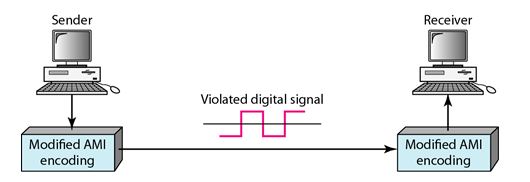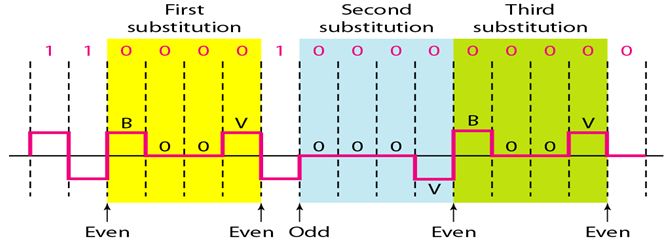Different Scrambling Techniques for Data Transfer:
Biphase schemes that are suitable for dedicated links between stations in a LAN are not suitable for long-distance communication because of their wide bandwidth requirement. The combination of block coding and NRZ line coding is not suitable for long-distance encoding either, because of the DC component. Bipolar AMI encoding, on the other hand, has a narrow bandwidth and does not create a DC component. However, a long sequence of Os upsets the synchronization. If we can find a way to avoid a long sequence of Os in the original stream, we can use bipolar AMI for long distances. One solution to this is called as scrambling.
If we can find a way to avoid a long sequence of Os in the original stream, we can use bipolar AMI for long distances. One solution to this is called as scrambling.
We modify part of the AMI rule to include scrambling, as shown in the following figure note that scrambling, as opposed to block coding, is done at the same time as encoding. The system needs to insert the required pulses based on the defined scrambling rules. Two common scrambling techniques are B8ZS and HDB3.
You May Also Like:
Line Coding and Its Characteristics
Different Line Coding Techniques
Different Block Coding Techniques
B8ZS Scrambling Techniques:
Bipolar with 8-zero substitution (B8ZS) is commonly used in North America. In this technique, eight consecutive zero-level voltages are replaced by the sequence OOOVBOVB.
The V in the sequence denotes violation; this is a nonzero voltage that breaks an AMI rule of encoding (opposite polarity from the previous). The B in the sequence denotes bipolar which means a nonzero level voltage in accordance with the AMI rule. There are two cases, as shown in the following figure.
Note that the scrambling in this case does not change the bit rate. Also, the technique balances the positive and negative voltage levels (two positives and two negatives), which means that the DC balance is maintained. Note that the substitution may change the polarity of a 1 because, after the substitution, AMI needs to follow its rules.
In this technique the letter V (violation) or B (bipolar) here is relative. The V means the same polarity as the polarity of the previous nonzero pulse and B means the polarity opposite to the polarity of the previous nonzero pulse.
HDB3 Scrambling Technique:
High-density bipolar 3-zero (HDB3) is commonly used outside of North America. In this technique, which is more conservative than B8ZS, four consecutive zero-level voltages are replaced with a sequence of OOOV or BOOV. The reason for two different substitutions is to maintain the even number of nonzero pulses after each substitution.
The two rules can be stated as follows:
1. If the number of nonzero pulses after the last substitution is odd, the substitution pattern will be OOOV, which makes the total number of nonzero pulses even.
2.If the number of nonzero pulses after the last substitution is even, the substitution pattern will be BOOV, which makes the total number of nonzero pulses even.
The following figure shows the HDB3 technique.
There are several points we need to mention here. First, before the first substitution, the number of nonzero pulses is even, so the first substitution is BOOV. After this substitution, the polarity of the 1 bit is changed because the AMI scheme, after each substitution, must follow its own rule. After this bit, we need another substitution, which is OOOV because we have only one nonzero pulse (odd) after the last substitution. The third substitution is BOOV because there are no nonzero pulses after the second substitution (even).
You May Also Like:
Analog to Digital Conversion Techniques
Different Transmission Modes
Back to DCN Questions and Answers



